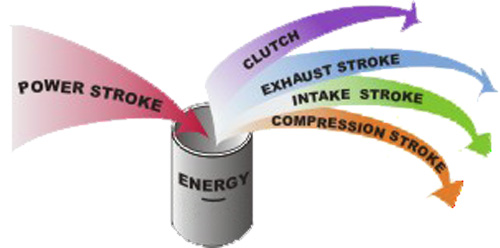Let me give you an engineer’s perspective.
Engine Dynamics
Your tachometer indicates only the average rotational speed of the engine. But if you had a sensor that could measure instantaneous rotational speed, you would see that the crankshaft is turning fastest during the expansion stroke, slows down a bit for the exhaust stroke, slows down more for the intake stroke and then really slows down for the compression stroke. Pushing out burned gases, drawing air into the cylinder and compressing the air requires work. That is why the engine slows down during three strokes. Only the expansion stroke after the spark plug fires produces energy and increases rpm. The average rotational speed for the whole cycle may be 4000 rpm but the instantaneous rotational speeds for the individual strokes might be 4095, 4020, 3990 and 3895 rpm.While the piston, connecting rod, crankshaft, flywheel and clutch are moving, they possess energy or the potential to do work. The  amount of energy varies with their speed.An engine that is not running has zero energy. It is necessary to get energy from an outside source (muscles or batteries) to get the cycle started. At idle speed the engine can just barely run by itself because the expansion stroke adds energy at the same rate as the other three strokes consume energy.
amount of energy varies with their speed.An engine that is not running has zero energy. It is necessary to get energy from an outside source (muscles or batteries) to get the cycle started. At idle speed the engine can just barely run by itself because the expansion stroke adds energy at the same rate as the other three strokes consume energy.
At higher speeds, the expansion stroke adds energy faster than the other three strokes consume energy hence there is a surplus of energy that can be used to move the kart and driver down the road.
Clutch Dynamics
The throttle determines how much energy the engine produces, but it is the clutch that determines how much energy gets to the axle and when it happens. Like the exhaust, intake and compression strokes, the clutch subtracts energy from the system. But unlike those strokes, the clutch does not extract energy with every turn of the crank. There are times when the engine produces a surplus of energy and times when it does not. The purpose of the clutch is to react to the engine’s energy level and siphon energy at the appropriate time and rate.
Clutch action is a function of rpm. It engages the engine at high rpm and disengages at low rpm. When the engine is turning slowly as in starting and idle, no extra energy is available.
The clutch senses this low speed, disconnects from the engine and takes zero energy from the reservoir in order to prevent the engine from stalling. When the engine is turning at high rpm, there is an excess of energy and the clutch senses the high speed and consequently connects itself to the engine which takes energy from the reservoir to move the kart.
Pulling Hard versus Hitting Hard
The “hard hit” clutch accelerates abruptly at first. It throws your head back but then acceleration tapers off quickly. The clutch is very popular because it has been around a long time and is fun to drive. And if every driver has one it is neither an advantage nor disadvantage.
The “hard hit” clutch takes energy from the reservoir as quickly as possible. But the aggressive nature of such a clutch also makes it slow to realize that it is stealing energy necessary to power the exhaust, intake and compression strokes. After the initial impact, the engine slows down a few hundred rpm because it just lost much of the energy needed to keep running. The engine needs time to recover but the clutch does not get the message immediately. It continues to drain energy and in extreme cases causes the engine to quit.
The “hard hit” clutch has another problem – it spins tires. Spinning tires look impressive and feel good but accelerate the axle not the kart. Instead of moving the kart forward, the energy from the engine is propelling stones and dirt backward and heating the tires. Now if your opponent’s tires slip less or not at all, then your loss is his gain. His engine moves the kart forward, your engine throws stones backward.
In contrast, the “hard pull” clutch accelerates at a constant rate. It feels much smoother and
perhaps a little less fun to drive. This clutch has not been around very long. A technical problem had to be solved to make such a clutch possible and for a long time we did not even know that a problem existed. Computer data acquisition systems provided evidence – hysteresis. Part of the solution was a faster reacting mechanism.
The “hard pull” clutch takes energy from the reservoir at a steady rate. It extracts surplus energy from the energy reservoir and nothing more. There is always adequate energy to drive the exhaust, intake and compression strokes. The engine does not bog down because the clutch is a very cooperative partner. The acceleration may be a bit less but it lasts a lot longer.
The “hard hit” and “hard pull” clutches are just like the hare and tortoise story. One jumps out quickly then takes a nap while the other starts off slowly but advances persistently and eventually wins.

